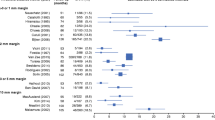Abstract
Backround: Breast conservation therapy is controversial for ductal carcinoma in situ (DCIS) due to recently reported high recurrence rates. We believe that cytologic evaluation of lumpectomy margins improves efficiency and leads to a lower recurrence rate following lumpectomy for DCIS.
Methods: A prospectively accrued database of 1255 breast cancer patients at the H. Lee Moffitt Cancer Center and Research Institute was found to have 218 patients with DCIS (17.4%). Of those 218 cases, 114 were treated with lumpectomy, axillary dissection, and radiation therapy; the remaining 104 patients were treated with mastectomy with or without reconstruction. Imprint cytology was used to evaluate all lumpectomy margins. Permanent sections and imprint cytology were reviewed by the same pathologist.
Results: All lumpectomy specimens (116 tumors in 114 patients) were evaluated. The median follow up was 57.5 months (range 2–110 months). One hundred and three patients with 104 tumors were selected on the basis of pure DCIS (with or without microinvasion), and treated with lumpectomy, axillary dissection and radiation therapy. Of the 104 tumors utilizing attempted breast conservation therapy, 7 (6.6%) required mastectomy. There were 6 recurrences (6.1%) with a median time for recurrence of 47.5 months (range 27–85 months); four recurrences were comedo and two were noncomedo at original diagnosis.
Conclusions: The determination of lumpectomy margins in DCIS patients using imprint cytology leads to an overall recurrence rate of 6.1% with reduction in operative time, and re-excision rate. Significant recurrence rates were associated with microinvasion and multifocal tumors (28%) versus simple DCIS at 5 years. Breast conservation therapy and surgical margin determination with imprint cytology for DCIS is a cost-effective and reliable method of treatment for simple DCIS.
Similar content being viewed by others
References
Rosner D, Bedwani RN, Vana J, Baker HW, Murphy GP. Noninvasive breast carcinoma: results of a national survey by the American College of Surgeons.Ann Surg 1980;192:139–47.
Baker LH. Breast Cancer Detection Demonstration Project: five year summary report.CA Cancer J Clin 1982;32:194–225.
Peters PHM, Verbeck ALM, Straatman H, Holland R, Hendricks JH, Mravunac M, Rothergatter C. Evaluation of overdiagnosis of breast cancer in screening with mammography.Int J Epidemiol 1989;18:295–9.
Schwartz GF, Patchefsky AS, Feig SA, Shaber GS, Schwartz AB. Clinically occult breast cancer: multicentricity and implications for treatment.Ann Surg 1980;191:8–12.
Rosen PP. Lobular carcinoma in-situ and intraductal carcinoma of the breast.Monogr Pathol 1984;25:59–105.
Lagios MD, Westdahl PR, Margolin FR, Rose MR. Ductal carcinoma in situ: relationship of extent of noninvasive disease to the frequency of occult invasion, multicentricity, lymph node metastasis, and short term treatment failures.Cancer 1982;50:1309–14.
Kinne DW, Petrek JA, Osborne MP, Fracchia AA, De Palo AA, Rosen PP. Breast carcinoma in-situ.Arch Surg 1989;124:33–6.
Silverstein MJ, Waisman JR, Gierson ED, Colbum W, Gamagami P, Lewinski BS. Radiation therapy for intraductal carcinoma: is it an equal alterative?Ann Surg 1991;126:424–8.
Hetelekidis S, Scnitt SJ, Morrow M, Harris JR. Management of ductal carcinoma in-situ.CA Cancer J Clin 1995;45:244–53.
Frazier TG, Wong RW, Rose D. Implications of accurate pathologic margins in the treatment of primary breast cancer.Arch Surg 1989;124:37–8.
Schnitt SJ, Connolly JL, Harris JR, Hellman S, Cohen RB. Pathologic predictors of early local recurrence in stage I and stage II breast cancer treated by radiation therapy.Cancer 1984;53:1049–57.
Recht A, Silver B, Schnitt SJ, Connolly J, Hellman S, Harris JR. Breast relapse following primary radiation therapy for early breast cancer: I. Classification, frequency and salvage.Int J Radiat Oncol Biol Phys 1985;11:1271–6.
Holland R, Hendricks JH, Verbeck ALM, Mravunac M, Stekhov JH. Extent, distribution, and mammographic/histological correlations of breast ductal carcinoma in situ.Lancet 1990;335:519–22.
Cox CE, Ku NN, Reintgen D, Greenburg HM, Nicosia SV, Wangensteen S. Touch preparation cytology of breast lumpectomy margins with histologic correlation.Arch Surg 1991;126:490–3.
Ernster VL, Barclay J, Kerlikowske K, Grady D, Henderson C. Incidence and treatment for ductal carcinoma in situ of the breast.JAMA 1996;275:913–8.
Bartelink H, Boider JH, Vandongen JA, Peterse JL. The impact of tumor size and histology on local control after breast conservation therapy.Radiother Oncol 1988;11:297–303.
Veronesi U, Banfi A, Del Vecchio M, et al. Comparison of Halsted mastectomy with quadrantectomy, axillary dissection, and radiotherapy in early breast cancer: long term results.Eur J Cancer Clin Oncol 1986;22:1085–9.
Silverstein M, Cohlan B, Gierson E, Furmanski M, Gamagami P, Colburn W, Lewinski B. Ductal carcinoma in situ: 227 cases without microinvasion.Eur J Cancer 1992;28:630–4.
Deng G, Lu Y, Zlotnikov G, Thor AD, Smith HS. Loss of heterozygosity in normal tissue adjacent to breast carcinomas.Science 1996;274:2057–9.
Lagios M, Margolin F, Westdahl P, Rose M. Mammographically detected ductal carcinoma in-situ.Cancer 1989;63:618–24.
Fisher E, Sass R, Fisher B, Wickerham L, Paik S. Pathologic findings from the NSABP-6 (DCIS).Cancer 1986;57:197–208.
Hardman PDJ, Worth A, Lee D, Baird RM. The risk of occult invasive breast cancer after excisional biopsy showing in situ ductal carcinoma of comedo pattern.Can J Surg 1989;32:56–60.
Wobbes T, Tinnemans JGM, van der Sluis RF. Residual tumor after biopsy for non-palpable ductal carcinoma in situ of the breast.Br J Surg 1989;76:185–6.
Schwartz GF, Finkel G, Garcia J, Patchefsky A. Subclinical Ductal Carcinoma In Situ of the Breast.Cancer 1992:70:2468–2474.
Klinberg VS, Westbrook KC, Korourian SR. Use of touch preps for diagnosis in surgical margins in breast cancer. Proceedings from Annual Cancer Symposia, Society of Surgical Oncology. March 1996, Altanta, GA.
Author information
Authors and Affiliations
Rights and permissions
About this article
Cite this article
Cox, C.E., Hyacinthe, M., Gonzalez, R.J. et al. Cytologic evaluation of lumpectomy margins in patients with ductal carcinoma in situ: Clinical outcome. Annals of Surgical Oncology 4, 644–649 (1997). https://doi.org/10.1007/BF02303749
Received:
Accepted:
Issue Date:
DOI: https://doi.org/10.1007/BF02303749




